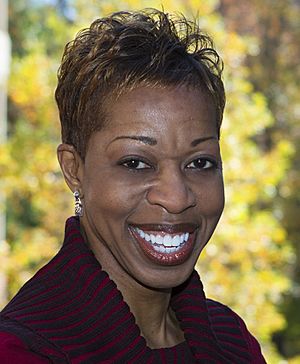Valerie Ashby facts for kids
Quick facts for kids
Valerie Ashby
|
|
|---|---|
 |
|
| President of the University of Maryland, Baltimore County | |
| Assumed office 2022 |
|
| Preceded by | Freeman Hrabowski |
| Personal details | |
| Born |
Valerie Sheares Ashby
September 6, 1966 Clayton, North Carolina, US |
| Education | University of North Carolina at Chapel Hill |
| Awards | |
| Scientific career | |
| Fields | Chemistry |
| Institutions | |
| Thesis | Synthesis and Characterization of Thiophene-Based Poly (Arylene Ether Ketones) and Poly (Arylene Ether Sulfones) (1994) |
| Doctoral advisor | Joseph DeSimone |
Valerie Sheares Ashby is an American chemist and a university leader. She is currently the president of the University of Maryland, Baltimore County (UMBC). Before this, she was a dean at Duke University. She also led the chemistry department at the University of North Carolina at Chapel Hill. Dr. Ashby and her research team hold ten patents for their work.
Contents
Early Life and Education
Valerie Ashby was born and grew up in Clayton, North Carolina. Her father was a high school math and science teacher. He first introduced her to the world of science.
Ashby earned her first degree in chemistry in 1988. She studied at the University of North Carolina at Chapel Hill (UNC). After graduating, she worked as a chemist at a company called Rhône-Poulenc. This company was located in Research Triangle Park.
Graduate Studies
Ashby went back to UNC for more studies in 1989. She worked as a research assistant in Professor Joseph DeSimone's lab. In 1994, she finished her advanced degree. Her research focused on making new types of plastics.
During her studies, Ashby also worked at IBM's Almaden Research Center in California. She spent the summer of 1992 there. In 1993, she worked at the Eastman Chemical Company in Tennessee. She studied how chemicals called catalysts affect colors in plastics.
Postdoctoral Studies
After earning her Ph.D., Dr. Ashby continued her research. She became a special fellow supported by the NSF and NATO. She worked at the Johannes Gutenberg University of Mainz in Germany. There, she studied how to create complex materials called ABC block copolymers.
Career Highlights
Iowa State University
Dr. Ashby started her teaching career at Iowa State University in 1996. She became an assistant professor there. By 2002, she was promoted to associate professor. While at Iowa State, she helped guide young women in science and engineering. She mentored students in a summer research program.
University of North Carolina – Chapel Hill
In 2003, Dr. Ashby spent time at the Massachusetts Institute of Technology. She then joined UNC Chapel Hill as an associate professor. In 2005, she received a grant from the NSF. This grant aimed to help more minority students earn advanced degrees in science and math. Her efforts helped increase the number of these students completing their Ph.D.s at UNC.
She became Vice Chair of Undergraduate Studies in 2005. In 2007, she was promoted to full professor. She also received a special teaching award. In 2012, she became the chair of the chemistry department. She also directed a program to support minority students in graduate school.
Throughout her time at UNC, Dr. Ashby received many awards. These awards recognized her research, teaching, and service.
Duke University
In May 2015, Dr. Ashby was chosen as the new dean of Trinity College of Arts & Sciences at Duke University. A special committee of professors, students, and leaders selected her. She started this important role in 2015.
University of Maryland, Baltimore County
On April 4, 2022, it was announced that Dr. Ashby would become the next president of UMBC. She officially started this role on August 1, 2022. She leads the university and helps guide its future.
Inventions and Patents
Dr. Ashby holds several patents for her scientific discoveries. These patents protect her inventions. They include new materials for medical uses and other technologies.
- "Polyester Based Degradable Materials and Implantable Biomedical Articles Formed Therefrom", issued 9/6/11, U.S. Patent No. 8,013,061
- "pH-Sensitive Methacrylic Copolymers and the Production Thereof", issued 1/07, U.S. Patent Number 7,160,971.
- "Functionalized Diene Monomers and Polymers Containing Functionalized Dienes and Methods for Their Preparation", Continuation issued 6/03, Patent No. 6,583,260
- "Functionalized Diene Monomers and Polymers Containing Functionalized Dienes and Methods for Their Preparation", Continuation Issued 2/02, Patent No. 6,344,538
- "Functionalized Diene Monomers and Polymers Containing Functionalized Dienes and Methods for Their Preparation", Issued 8/00, Patent No. 6,100,373
- "High Performance Fluorinated Polymers and Methods", Issued 2/03, Patent No. 6,515,101
- "Polyester Based Degradable Materials and Implantable Biomedical Articles Formed Therefrom", Issued 2/13, Patent No. 8,383,725


